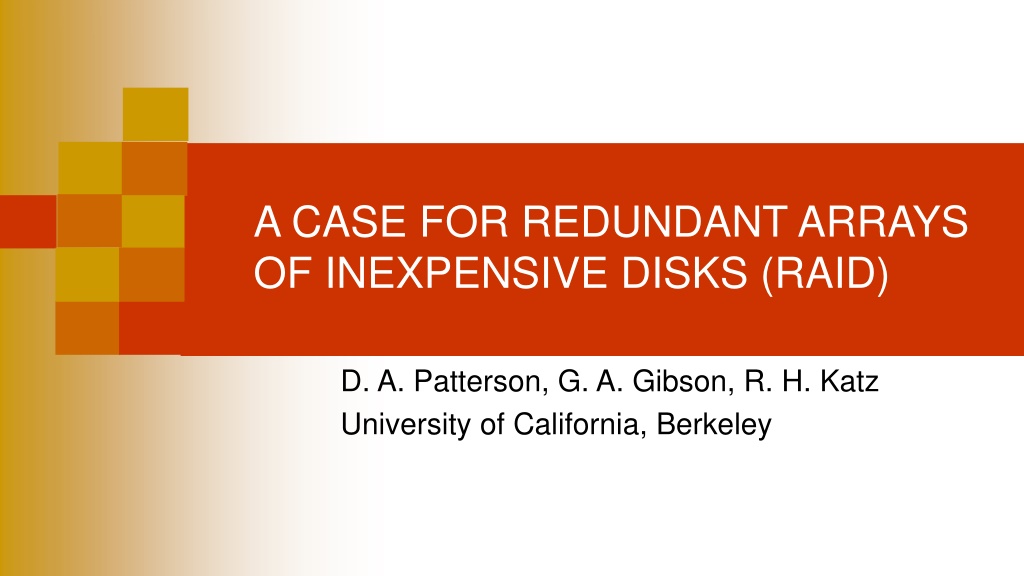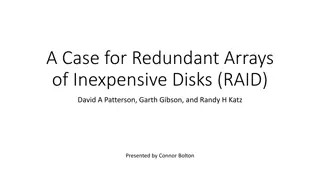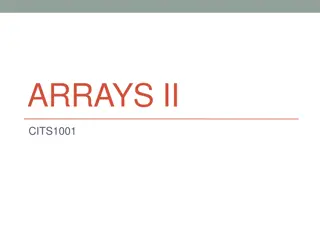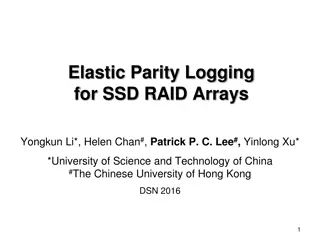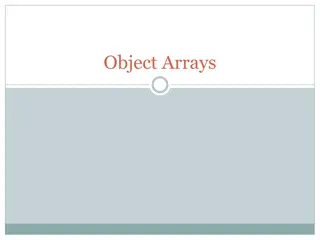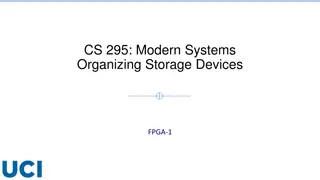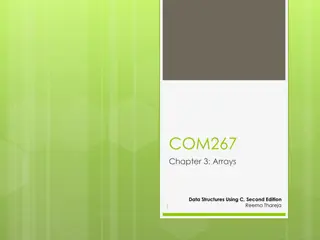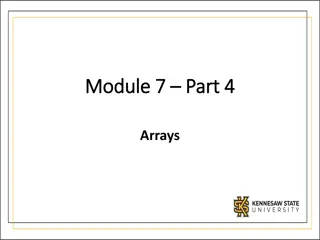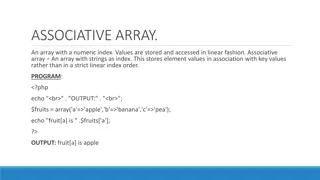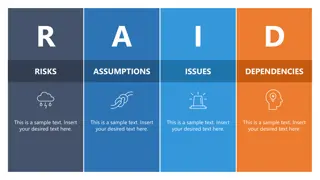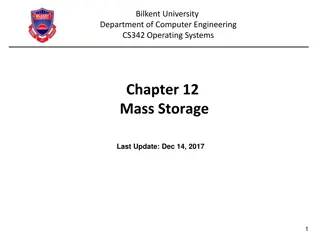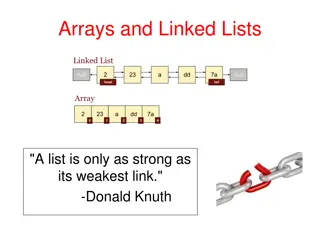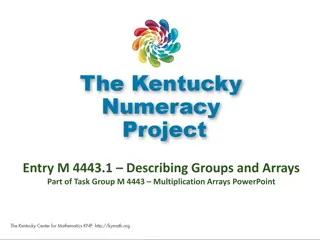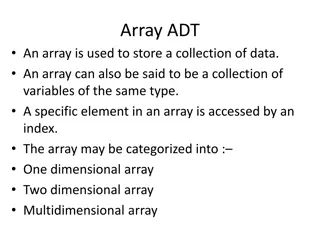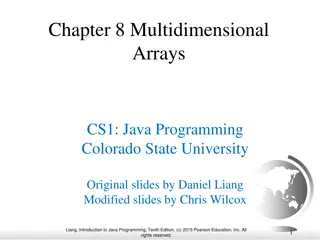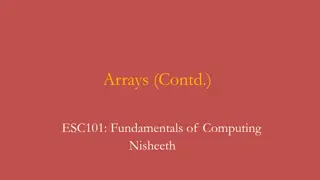Understanding Redundant Arrays of Inexpensive Disks (RAID)
This informative material discusses the concept of RAID, its various levels such as RAID 0, 1, and 2, their advantages and disadvantages, and the motivation behind implementing RAID systems. It highlights the need for data redundancy, disk throughput optimization, and reliable storage solutions using inexpensive disk arrays.
Download Presentation

Please find below an Image/Link to download the presentation.
The content on the website is provided AS IS for your information and personal use only. It may not be sold, licensed, or shared on other websites without obtaining consent from the author. Download presentation by click this link. If you encounter any issues during the download, it is possible that the publisher has removed the file from their server.
E N D
Presentation Transcript
A CASE FOR REDUNDANT ARRAYS OF INEXPENSIVE DISKS (RAID) D. A. Patterson, G. A. Gibson, R. H. Katz University of California, Berkeley
Highlights The six RAID organizations I added RAID level 6 Why RAID 1, 3, 5 and 6 are the most interesting The small write problem occurring with RAID 5 and 6 WARNING:Skip the reliability and availability analyses: they are not correct
Original Motivation Replacing large and expensive mainframe hard drives (IBM 3310) by several cheaper Winchester disk drives Will work but introduce a data reliability problem: Assume MTTF of a disk drive was then 30,000 hours MTTF for a set of n drives is 30,000/n n = 10 means MTTF of 3,000 hours
Todays Motivation Cheap SCSI hard drives are now big enough for most applications We use RAID today for Increasing disk throughput by allowing parallel access Eliminating the need to make disk backups Disks are too big to be backed up in an efficient fashion
RAID level 0 No replication Advantages: Simple to implement No overhead Disadvantage: If array has n disks, failure rate is n times the failure rate of a single disk
RAID levels 0 and 1 RAID level 0 Mirrors RAID level 1
RAID level 1 Mirroring Two copies of each disk block Advantages: Simple to implement Fault-tolerant Disadvantage: Requires twice the disk capacity of normal file systems
RAID level 2 Error correction code Very bad idea Disk drives either work correctly or do not work at all Only possible errors are omission errors We need an omission correction code A parity bit is enough to correct a single omission Error correction codes are widely used inside the disk controller to handle read errors caused by surface imperfections,
RAID levels 2 and 3 Check disks RAID level 2 Parity disk RAID level 3
RAID level 3 Requires ? + 1 disk drives ? drives contain data (1/? of each data block) Block ?[?] now partitioned into ? fragments ?[?,1],?[?,2], ?[?,?] Parity drive contains exclusive or of these ? fragments ?[?] = ?[?,?] ?[?,?] ?[?,?]
How parity works? Truth table for XOR (same as parity) A B 0 1 1 0 A 0 0 1 1 B 0 1 0 1
Recovering from a disk failure RAID level 3 array with data disks D0 and D1 and parity disk P Can tolerate failure of either D0 or D1 D1 P=D0 0 0 1 1 D0 P=D1 0 1 0 1 D0 0 0 1 1 D1 0 1 0 1 P 0 1 1 0
How RAID level 3 works (I) Assume we have ? + 1 disks Each block is partitioned into ? equal chunks Block ? = 4in example Chunk Chunk Chunk Chunk
How RAID level 3 works (II) XOR data chunks to compute the parity chunk Parity Each chunk is written into a separate disk Parity
How RAID level 3 works (III) Each read/write involves all disks in RAID array Cannot do two or more reads/writes in parallel Performance of array not netter than that of a single disk
RAID level 4 (I) Requires ? + 1 disk drives ? drives contain data Individual blocks, not chunks Blocks with same disk address form a stripe
RAID level 4 (II) Parity drive contains XOR of the ?blocks in stripe ?[?] = ?[?] ?[? + ?] ?[? + ? ?] Parity block now reflects contents of several blocks! Can now do parallel reads/writes
RAID levels 4 and 5 Bottleneck RAID level 4 RAID level 5
RAID level 5 Single parity drive of RAID level 4 is involved in every write Limits parallelism RAID level 5 distribute the parity blocks among all the drives Much better
The small write problem Specific to RAID 5 Happens when we want to update a single block Block belongs to a stripe How can we compute the new value of the parity block p[k] ... b[k+2] b[k] b[k+1]
First solution Read values of? ? other blocks in stripe Recompute ?[?] = ?[?] ?[? + ?] ?[? + ? ?] Solution requires ? ? reads Two writes (new block and new parity block)
Second solution Assume we want to update block ?[?] Read old values of ?[?] and parity block ?[?] Compute ?[?] = ??? ?[?] ??? ?[?] ??? ?[?] Solution requires Two reads (old values of block and parity block) Old value of block is likely to be in I/O buffer Two writes (new block and new parity block)
How it works Old Data New Data 0 0 Old Parity 0 0 New Parity 0 1 0 1 FLIP FLIP FLIP FLIP 0 1 0 1 0 1 0 1 0 1 0 1 0 1 1 1 0 0 1 1 0 0 1 1 0 0 1 1 FLIP FLIP 0 0 1 1 1 1 0 0 0 0 1 1 1 1 1 0 1 0 0 1 0 1 1 0 1 0 0 1 FLIP FLIP FLIP FLIP FLIP FLIP FLIP FLIP FLIP FLIP FLIP FLIP FLIP FLIP FLIP FLIP FLIP FLIP FLIP FLIP FLIP FLIP FLIP FLIP FLIP FLIP
More recent RAID organizations (I) RAID 6: Two check disks Tolerates two disk failures More complex updates Current standard
More recent RAID organizations (II) RAID 10: Also known as RAID 1+0 Data are striped (as in RAID 0 ) over pairs of mirrored disks (RAID 1) RAID 0 RAID 1 RAID 1 RAID 1 RAID 1 Y
What about flash drives? Having no moving parts should mean fewer failures? Failures still happen Flash drives age as they are written to Irrecoverable read errors occur (at least as frequently as in magnetic disks?) Pure Storage uses a proprietary 3D-RAID organization for their SSD stores
CONCLUSION (I) RAID original purpose was to take advantage of Winchester drives that were smaller and cheaper than conventional disk drives Replace a single drive by an array of smaller drives Current purpose is to build fault-tolerant file systems that do not need backups
CONCLUSION (II) For small installations RAID level 1 attractive for small installations Otherwise RAID level 6 for higher protection Tolerates one disk failure and irrecoverable read errors
A review question Consider an array consisting of four 2TB disks What is the storage capacity of the array if we organize it As a RAID level 0 array? As a RAID level 1 array? As a RAID level 5 array?
The answers Consider an array consisting of four 2TB disks What is the storage capacity of the array if we organize it As a RAID level 0 array? 8 TB As a RAID level 1 array? 4 TB As a RAID level 5 array? 6 TB
